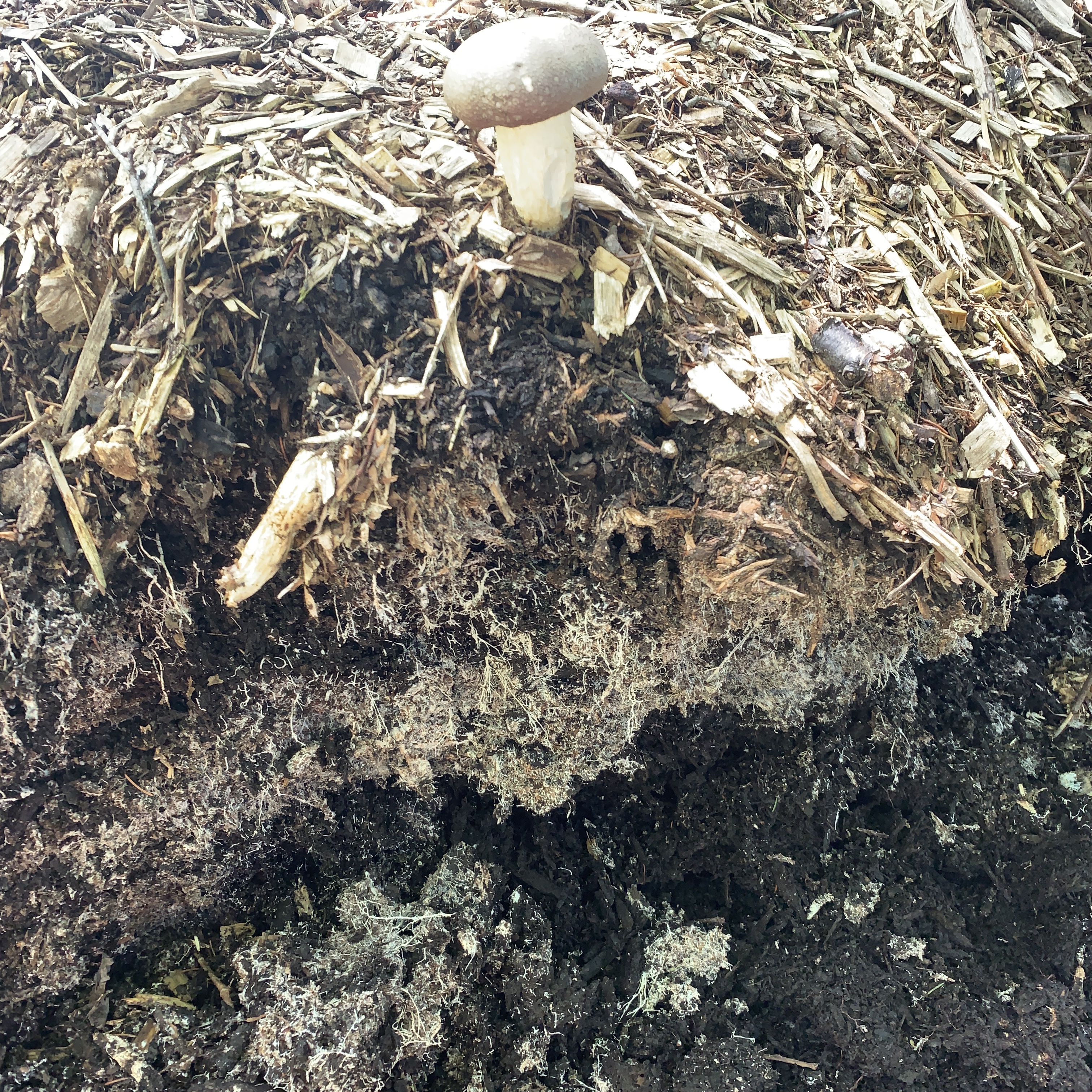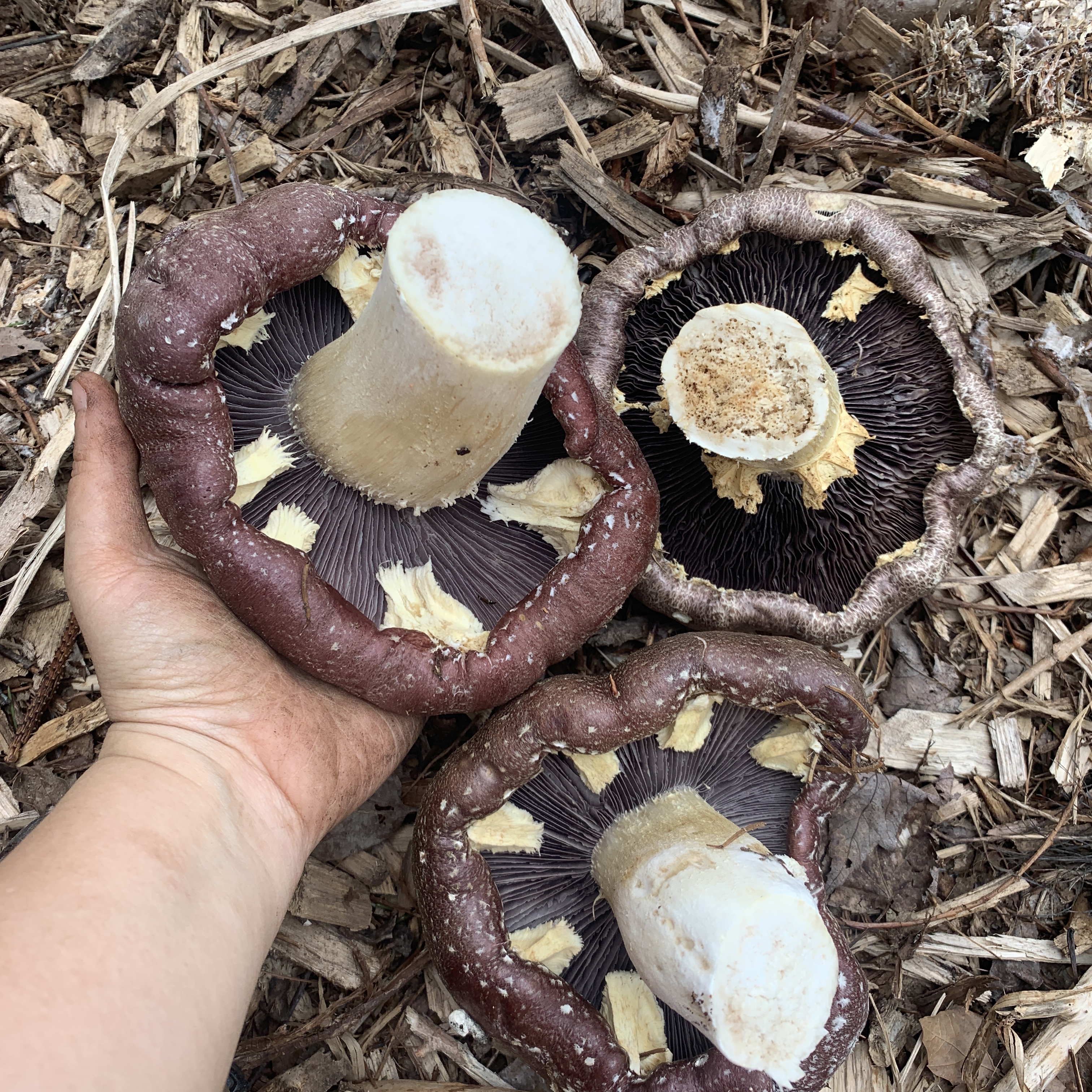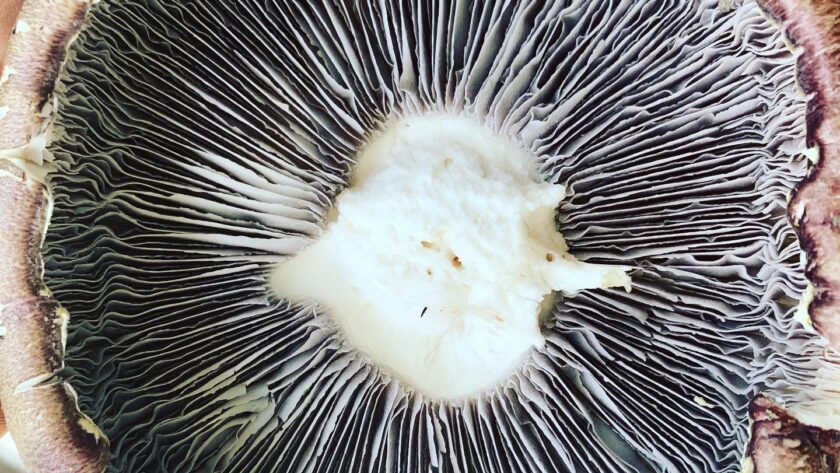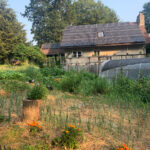How many times have you seen your neighbors getting tree work done or had tree work done yourself? The landscape company often comes with the big wood chipper and truck and then, after cutting up the wood, hauls that beautiful pile of chips off to some unknown location. Last year, our electric company came through and was doing tree work along our driveway and road to prune and cut trees too close to the power lines. We asked them to dump the wood chips on our property, and they were happy to do so. A lot of times, companies have to pay or go far out of their way to dump wood chips, and they see them as a “waste”; they will almost always dump them for free if you ask! But a pile of wood chips is hardly a waste–they can offer you multiple yields over a period of years. In today’s post, we’ll look at mushrooms from a permaculture and druidic perspective and see one way we can use them to both understand nature’s alchemy as well as cultivate home-grown food, focusing on using fresh wood chip piles.

About Mushrooms
Mushrooms are amazing: they are in a kingdom by themselves (fungi) and are in a kingdom all to themselves. They do not contain chlorophyll, so they are unlike plants. They are saprophytes, breaking down organic matter (usually wood) and feeding on the nutrients contained within. In this way, they work as part of nature’s system of decomposition, breaking down the old so that the new can begin again. Their “bodies” consist of fungal hyphae (which are white or tan lines or threads that run through soil, wood, etc). The threads are also called mycelium. They also consist of the fruit, which is what we call a mushroom. The fruit of the mushroom is actually its reproductive system, which is what the mushroom itself sends up to reproduce (via spores, in most species).
I think we can learn a lot from the mushroom kingdom, both from a permaculture perspective as well as a spiritual/druidic perspective. On the permaculture side, the mushrooms remind us that nothing is waste: they can break down not only wood but also many of our own human wastes: cardboard, newspaper, office paper, and coffee grounds. Amazingly, they can also be used to pull toxins and do “mycoremediation” to help damaged sites heal. this includes pulling toxins and pollution from soil as well as pulling toxins and oils in water contaimination. Mushrooms are truely amazing! On the spiritual side, the mushroom is one of the great alchemists of nature: taking waste (dross) and turning it into soil which can then can nourish plants–the soil is what the entire ecosystem is based upon!

The mushroom we are talking about today is the Wine Cap mushroom, also known as King Stropharia (stropharia rugoso-annulata), sometimes also called “Composter mushrooms” or “Garden giants.” You can purchase these online from a variety of mushroom companies; my spawn came from Tradd Cotter’s Mushroom Mountain. I’ve had the pleasure of taking multiple workshops from Tradd at our local Mother Earth News Fair, and I like his company and ethics a lot! The nice thing about these mushrooms in particuar is that they are versitile and easy to keep cultivating. Once you have some mycelium, its possible to keep spreading these mushrooms as long as they have something to eat. So if you have your own chipper, a ready supply of leaves or other compost waste, these mushrooms will keep on going! So let’s talk about a few ways you can work with Wine caps.
Wood Chips
The techniques that I am sharing today only work on a fresh woodchip pile (less than a few weeks old). If you try this with an older wood chip pile, or in a pile that has been dead wood recently chipped, it is likely that other species of mushrooms have already colonized your pile. What this means, then, is that when you try to colonize your pile with your own mushroom spawn, there may be considerable competititon and you may not get the mushrooms you hope to get (You also need to be *very* careful about ID in this case).
As I mentioned in the introduction, wood chips are fairly easy to obtain in many parts of the US, at least. You might be able to get them from local muncipalities, and certainly, from local private tree services. Most of them are all too happy to drop off piles of mulch to you so they don’t have to drive far to dump them and/or pay to have them dumped. You may also be doing some of your own brush clearings; again, any fresh woodchips will do for this process.
Seeding Your Pile
To seed your pile, simply break up your mushroom spawn into smaller pieces, dig holes in your pile (a foot or less down) and add the spawn. After the pile was dumped, in early August, a few of my druid friends and I seeded our pile in about 15 minutes.

In addition to moisture and food, mushrooms need oxygen. If your pile is too tightly compacted, you may only get mycelium growing on the top of the pile. Never fear–once you remove some of the mulch for other purposes (see below), the mycelium can colonize further into the pile.
Fruiting
At some point, typically for Wine Caps, when the temperatures hit above 60 degrees, your pile will start to fruit. Our pile started fruiting in April, and is still fruiting at the beginning of June. Thus far, we’ve harvested at least 20 lbs of mushrooms from the pile. As exciting as the huge wine cap mushrooms are, they often get buggy and full of worms. Thus, it is best to harvest the smaller mushrooms to eat and leave the larger ones in the pile to spore and to produce food for others.
Spreading the Mushroom Love: Mushrooms in the Garden and More
Once you have an innoculated pile, you can use your wood chips all through your garden and as mulch. Anywhere you do this, you are likely to get mushrooms popping up, which is an amazing food production source! Here are some of the many possibilities:
- Mulched Mushroom Garden Paths: Add several layers of cardboard to your garden paths and then mulch with a thick layer of innoculated wood chips. Your paths will last at least 2 years, and probably at some point, they will fruit with mushrooms.
- Mulched Mushroom Garden Beds: All garden beds benefit from mulching. If you look at a forest, you will never see bare soil on the forest floor: it is always mulched with a rich pile of leaves, etc. This helps the forest prevent erosion and retain nutrients. Many gardeners leave their soil bare, which allows the sunlight to quickly strip it of moisture. By adding a thick layer of mulch (straw, leaf rot, or wood mulch) you can prevent the loss of mosture, and likely, never have to water your garden again. That’s my method: layers of mulch equals never needing to water, unless we have some kind of severe drought! Adding your mushroom-innoculated mulch to your beds benefits the whole garden. This page offers a lot more details on this practice, debunks myths about wood chips in the garden, and offers information on why it works. Keep your wood chip mulch to 2-3″ deep at the most and you will have no probmes–and you will get more mushrooms. In fact, every place that we have spread this mulch has fruited at least once this spring!
- Mulched Tree Areas: Your trees, likely, can also benefit from some innoculated mulch. I put this around my fruit trees, being careful not to mulch the trunks too closely. This does the same thing for the trees that it does for the garden!
- Mulched Paths: You can mulch any other paths with this approach, including forest trails and so on. I am working on some forest trails through our wooded areas, and these mushroom mulched paths are a wonderful addition. Again, I use thick layers of newspaper or cardboard (when necessary) or simply mulch (if the forest floor is largely bare, as mature forests sometimes are). You can further get fancy and line your mulched paths with stones. Part of why I do this is that our tick issues in Western PA have grown extremely intense; it is better for us to mulch and keep nice wide paths than to be covered in ticks (we also have guinea fowl and chickens for tick patrol, and they do a great job!)
- Mulched Planters: You can also mulch container garden pots and planters with a light layer of this mushroom mulch. You may not get any fruiting mushrooms (I haven’t seen any on ours yet) but you certainly will get the benefit of the water retention!

Wine Cap Cuisine
Wine caps are a mild and delicious mushroom, with a growth habit similar to a portabella. They do not have a strong flavor, and when they cook, they produce a lot of liquid, which needs to be accounted for in any recipe. For the best way to taste the mushroom flavor itself, you can simply fry these in some olive oil or put them on the grill brushed with olive oil. You can also stuff them (I like to stuff them with rice, veggies and cheese) or make a simple cream of mushroom soup. Essentially, any recipe that calls for a portabella mushroom can be instead used with a wine cap. Here’s one such recipe I made this week
Wine Cap Mushroom Soup
- 1 lb of wine cap mushrooms, washed and sliced
- 1/2 cup marsala wine
- 2 tbsp olive oil
- fresh thyme, chives, and parsley
- 1 onion
- 2 garlic cloves, crushed
- 1 cup sliced kale
- 1 quart vegetable or chicken broth
- 1 cup heavy cream
- salt and pepper to taste
Sautee the mushrooms in olive oil until they start to soften (about 5 min). Add the wine, onions, and garlic, and simmer for an additional five minutes. Add the broth, herbs, and salt/pepper and put a lid on your soup, allowing it to cook for 15 more minutes until the mushrooms and onions are tender. Remove from heat. Add kale and heavy cream, and let the flavors meld on the stove for 10-15 min before serving. Serve with some fresh chives on the top.

Radical Mushrooms: Kitty Litter and Other Decomposition Projects
I didn’t stop with the wood chip pile with regards to how to keep working with the Wine Cap mushrooms. I wanted to use mushrooms t help break down other “waste” products at the house. have three cats, and they have long been using natural plant-based cat litters, usually a pine base or a wheat-based litter. I saw instructions like these, knowing that people use kitty litter (fresh) for mushroom cultivation for eating. While I had no intention of eating mushrooms grown in used kitty litter, In this case, I was wondering if the mushrooms would work in this litter to help break it down (and thus not put it in a landfill, but return those nutrients to nature). I first started with a regular compost pile, putting a few palattes together, which in about 1.5 years, was full of cat litter. I put some mushroom spawn in the pile in the fall, at the same time I seeded the much larger mulch pile, but nothing happened. I think it had too much ammonia and not enough oxygen. I took the palatte composter apart, and instead, spread the kitty litter in a thinner area, only about 6″ deep. I again seeded it with mushroom spawn: and this time, it worked. I now have a kitty litter composting area. I add litter only to one side and allow the mushrooms to slowly break down the litter that has sat longer. This simply stays on the edge of the woods, effectively eliminating the landfill and returning those nutrients to the earth. I call this a mushroom win! I will also note that I do *not* pick or eat the mushrooms in this pile, but other wildlife seems to enjoy them.
I hope this brief look into how to tranfsorm “waste” into resources for the druid’s garden is helpful and inspirational to you!




Reblogged this on Blue Dragon Journal.
Reblogged this on Paths I Walk.
Mushrooms are treasures, just like this blog. I can use mushrooms to help compost down the kitty litter? Wonderful! Have been spreading the litter around the garden which I then (later, much later) cover with fallen leaves, however adding fungi just has to be good. Must check for my local ‘shroom supplier. 🍄
Yes! If you are using a wood-based one. I think it would also work with wheat or other grain based ones. I have used King Stropharia as well as Oysters.
Reblogged this on Rattiesforeverworldpresscom.
Reblogged this on Good Witches Homestead.
What an informative read, thanks for putting this out into the Universe!
You are most welcome! 🙂
[…] via Wine Cap Mushroom Cultivation: Wood Chips, Garden Beds, Recipes, and More — The Druid’s Gard… […]
Thanks for the reblog!
Very informative! Thank you
You are most welcome! 🙂
I have a real passion for fungi. I just love the work that it does in the environment particularly until now, how it allows trees and other plants to communicate and the symbiotic relationship they have. Now I have a new and greater fascination and respect for the magical world of fungi. Your article has inspired me to propagate not just observe all the different types of fungi. Incidentally, I have photographs of different types of fungi growing in my potted plants and trees. Thank you for a wonderful read.
Fantastic! There is a whole world of fungus propagation–its actually a lot easier than you think! I’ve had good success with these as well as with mushroom logs (I have some Shitake logs getting ready to fruit!)
“Seed” should never be used in any capacity in regards to mushrooms/MYCOLOGY. grain spawn/spawn . Spores. No seeds involved in mushrooms unless you’re considering the grain, used to make grain spawn, seed.